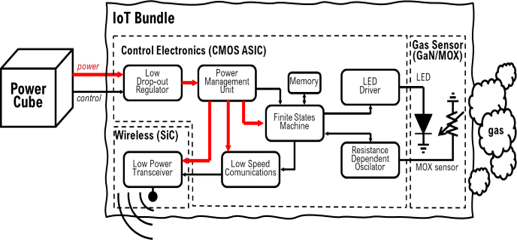In FOXES, we will develop an IoT Bundle that include a gas sensor element and the necessary control and communication electronics.
| Technical Objectives: | •Light-activated semiconductor gas sensor with operation power <10 μW •Sensor node with operation power < 50 μW |

The power efficiency of this IoT Bundle will be maximized as follows:
- On the gas sensor side, a new device architecture will be adopted and optimized: the “micro light plate”, based on miniaturized power-efficient LEDs activating the sensor (see Figure 1.6). Here we aim at power consumptions in the sensor element of less than 10 mW. This is a reduction of more than 4 orders of magnitude with respect to conventional gas sensors, and it is possible as a further miniaturization effort of the micro light plate concept.
- On the electronics side, a full custom ASIC device will be developed to give us full flexibility to meet the power constrains of FOXES. This own design will include an optimized power management stage, an efficient digital control and data processing unit, a custom signal conditioning and acquisition stage, as well as an interface with a state-of-the-art wireless transceiver. The latter will be incorporated with a commercial low power System-in-Package (e.g. BLE). Using power budget models developed by some of the project partners, the sequencing and timing of the data generation, acquisition, storage and transmission will be optimized to meet a power consumption < 50 mW.
Finally, regarding the use case, we will apply the FOXES autonomous sensor nodes to monitor two of the pollutants that deserve today most of the attention in urban areas: NO2 and O3.
